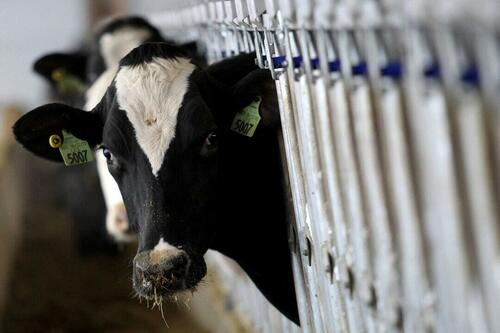And of course it’s the bogus PCR test which is inappropriate for this task, and known to give false positives, especially if you spin it up too much. Consequently, I’m about to go have a glass of local raw milk with a pastry, and I have a post on how much nutrition is in raw milk verses pasteurized. I’m guessing this is going to be a grift for mRNA gene therapies to be given to all cattle making the OCGFC a lot of money. They might also be targeting states that allow nutritional raw milk to be sold, as that nutrition can make you healthier and get you out of their medical and pharmaceutical wealth transfer scheme. Also worth noting, in previous reports cattle infected with the virus had off colored milk for which they would be quarantined and the milk discarded, and the cattle would recover fine. Some reports of mRNA vaccines used in pork led to a percentage dying off, but they don’t live that long before harvesting. Milk cows can be used for 5-6 years before being butchered, and a faulty mRNA gene therapy could be disastrous for herds already severely depleted because large cattle operations couldn’t get rail feed deliveries. And we know their mRNA products damage immune systems among many other issues, so for large operations it could be even more disastrous, causing beef prices to increase much higher. All while they tell us we need to eat less beef to save the planet for their climate hoax and the great reset, while increasing insect protein operations and starting to add it to processed food.
Acheta domesticus may be on the label – it is Cricket. Some are hiding it by calling it “Acheta Protein” and promoting it as a great alternative to animal protein.
https://getbetterwellness.com/cricket/
https://www.zerohedge.com/commodities/20-percent-retail-milk-samples-positive-bird-flu-fda
By Zachary Stieber at The Epoch Times
One in five samples of milk from grocery store shelves tested positive for the highly pathogenic avian influenza, the U.S. Food and Drug Administration (FDA) announced late April 25.

In a brief 237-word update, the FDA said that initial results from a national commercial milk sampling study “show about 1 in 5 of the retail samples tested are quantitative polymerase chain reaction (qPCR)-positive for HPAI viral fragments, with a greater proportion of positive results coming from milk in areas with infected herds.”
The FDA has refused to disclose how many samples it tested and from which stores the samples came, and a Freedom of Information Act request for the information has not yet yielded results.
Thirty-three cattle herds across eight states—Idaho, Kansas, Michigan, New Mexico, North Carolina, Ohio, South Dakota, and Texas—have tested positive for avian influenza, commonly known as the bird flu, according to the U.S. Department of Agriculture. Poultry in Minnesota and a person in Texas have also become infected with the same genotype of the H5N1 avian influenza strain found in cattle.
Authorities have stressed that positive results from qPCR testing do not mean the pasteurized milk contains intact virus, because the testing can return positive based on fragments of residual virus.
“Additional testing is required to determine whether intact pathogen is still present and if it remains infectious, which would help inform a determination of whether there is any risk of illness associated with consuming the product,” the FDA said.
Testing includes injecting eggs with samples that tested positive and seeing whether any active virus replicates.
In another round of testing, conducted by a team from Ohio State University, 58 of 150 milk samples gathered from grocery stores across six states tested positive for bird flu.
“We’ve screened them for the presence of influenza genetic material, so the viral RNA. Those that have tested positive, we have been forwarded to St. Jude Children’s Research Hospital, where they are conducting studies to see if there’s a viable virus in there. To date, none of them have been viable, but certainly they give the indication that there is viral genetic material in the region,” Dr. Andrew Bowman, an associate professor at Ohio State University, told the Bovine Veterinarian magazine.
“The fact that you can go into a supermarket and 30 percent to 40 percent of those samples test positive, that suggests there’s more of the virus around than is currently being recognized,” Richard Webby, a virologist at St. Jude’s, told STAT News.
The FDA has said it will release more details about the testing in the future. Raw milk from farms with affected cows has also tested positive for bird flu.
Authorities initially said that pasteurized milk was definitely safe but have since acknowledged that they’re not sure whether milk in grocery stores contains live bird flu virus. The FDA announced Tuesday that some samples tested positive for the influenza.
Officials say it’s still safe to drink milk but some outside experts, including former U.S. government official Rick Bright, have said they’re going to hold off until more information is made public about the outbreak.
The U.S. Department of Agriculture only required testing dairy cows showing symptoms of the flu but, starting Monday will require lactating cows to test negative before being moved across state lines.
The flu originated in birds but has since moved to other animals, including cattle and goats.
The person in Texas, and an individual in Colorado who became sick in 2022, are the only humans with confirmed cases of the H5N1 version in the United States.
Monitoring of people who have come into contact with animals has only covered 44 people so far, Sonja Olsen, an epidemiologist with the U.S. Centers for Disease Control and Prevention, told an Association of State and Territorial Health Officials webinar this week. Twenty-three people who showed symptoms were tested. The person in Texas, a farm worker, has been the only person to test positive so far.